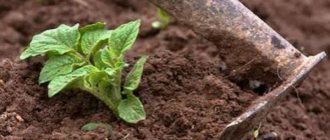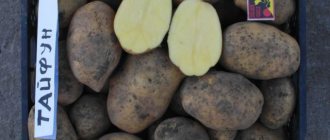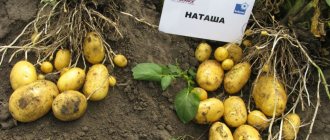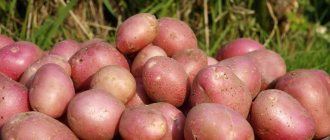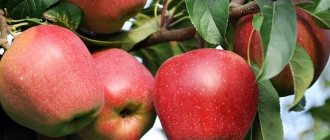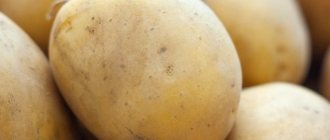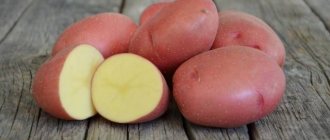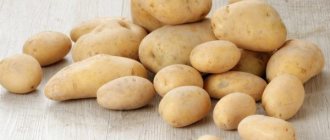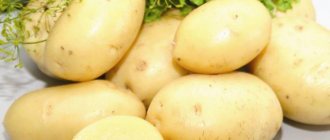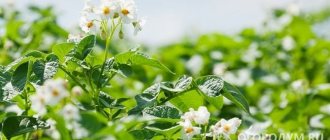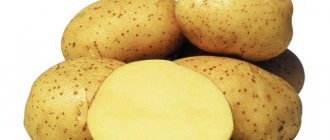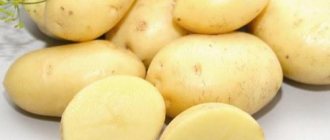Adretta potatoes are one of the favorite varieties of summer residents, known for more than 40 years, characterized by high taste. Created by German breeders, it is recommended for cultivation in Belarus, the Middle Volga region, Western Siberia, and the Russian Far East. Adretta is suitable for planting in small areas and in large quantities for sale and industrial processing.
The variety is tasty, characterized by unpretentiousness and high yield. The article describes in detail about Adretta potatoes, provides a description of the variety, photos, and reviews.
Description of the variety
Adretta is a table variety. The technical maturity of root crops is noted 70-80 days after the appearance of shoots. In the initial period of the growing season, the plant is characterized by rapid growth. The shoots are strong and actively growing. Tubers form and develop together.
The bush is tall compared to other varieties, erect, not spreading. The leaves are large and medium-sized, light green. Flowering is abundant. The inflorescences consist of small white flowers.
Adretta tubers are mostly medium in size, weighing 100-150 grams, covered with many small, shallow eyes. The shape of the tuber is oval, of different lengths. The peel is yellow, rough, with a mesh. The pulp is light yellow or deep yellow. After cooking, it acquires a soft crumbly structure with the formation of medium-sized grains. The variety is suitable for inclusion in the menu in boiled form, for preparing first courses, chips.
The main varietal characteristic is the yellow color of the tuber pulp, indicating the presence of carotenoids in the composition. The pulp is rich in proteins, starch, and vitamins.
The agrotechnical qualities of the Adretta potato variety are excellent. The Adretta harvest is harvested in late August - early September. The collected tubers are dried in a dry and well-ventilated place, not in the sun.
The table provides detailed characteristics of the variety.
| Options | Varietal characteristics of potatoes |
| purpose | for planting in open ground |
| maturation period | mid-early |
| number of tubers in one plant | 10-25 pieces |
| productivity | up to 450 c/ha, up to 2 kg per bush |
| marketability | 85% |
| keeping quality | 95% |
| amount of starch | 15-18% |
| consumer rating | 5 points out of 5 (excellent taste) |
| culinary type | C (medium crumbliness after cooking) |
| breeder | German company Norika Nordring-Kartoffelzucht und Vermehrungs |
Harvest and storage
The Adretta harvest is usually carried out at the end of August or in the first days of autumn. By this time, the tops are completely dry and fall apart in different directions. For those who grow Adretta for the first time, it may seem that the club formations are not compact. The fruits in the ground are scattered from each other.
Many varieties experience slight changes in the taste of potatoes due to temperature changes; they become sweet. However, Adretta is devoid of this unpleasant property. Moreover, the taste is preserved even during long-term storage.
Harvesting is best done in dry weather, when the soil is well cleared from the fruit. In any case, the harvested crop must be thoroughly dried, but not under the scorching sun, but in a well-ventilated, dry place. Excessive moisture can cause fungus and rot to develop, and the potatoes may not survive the winter.
When the harvest has rested, it is collected in chests or bags and lowered into the cellar. Fruits must be stored in cool conditions. The basement should be well ventilated and the temperature should not exceed three degrees. If all conditions are met, then by spring the potatoes will be well preserved and can be used for seeds.
Attention! Potatoes should never be washed before storing! This can lead to early rotting of the crop.
Advantages and disadvantages
Among the advantages of the Adretta variety, it should be noted:
- high productivity;
- rapid ripening of root crops (you can get two harvests during the growing season);
- a large number of tubers that persist until spring;
- susceptibility to feeding;
- saturation of root vegetables with useful substances;
- the ability to prepare a variety of dishes;
- unpretentiousness in cultivation;
- low susceptibility to major diseases and pests characteristic of nightshade crops (cancer, nematodes);
- resistance of shoots to sharp drops in temperature.
Varietal deficiencies:
- potato susceptibility to dry periods;
- tendency to damage shoots by late blight, scab, and Colorado potato beetle;
- rapid germination of stored tubers.
Growing
Unpretentiousness is a quality that is greatly appreciated by anyone who has ever grown their own vegetables and root crops. This is a very complex process that requires attention, patience and a lot of work. When growing, every gardener hopes to get a rich harvest of excellent quality with high shelf life. Unfortunately, this is not always the case, especially for beginners.
In order for the harvest to be rich and healthy, it is not enough to choose the right variety. Proper cultivation is the key to success. Potatoes of this variety have excellent agrotechnical qualities:
- unpretentious to grow;
- resistant to major diseases;
- has high productivity;
- tolerates low temperatures well.
Important! This variety can be planted in mid-spring if the soil is warm. It will produce a harvest in early July, which is considered quite early.
Before sowing the seeds, it is recommended to soak them in water for 1-2 days. This will allow them to ascend faster. The water should be at room temperature.
Advice! Do not purchase seed potatoes from your own hands; they may be of poor quality. In specialized stores, Adretta potatoes are always present on the shelves.
The best soils for it:
- light loams;
- sandy loam;
- soddy-podzolic.
You should not add manure that is harmful to the taste of the soil. It is also necessary to pay attention to groundwater. They should be located no higher than one meter. “Adretta” seeds are tubers that can be planted in open ground as early as April if you live in the southern regions. You can harden them in advance:
- Place the soaked seeds in the refrigerator overnight (temperature +1-2 degrees);
- maintain warm temperatures during the day (+22-24 degrees).
Advice! If there is very little seed material, the potato tubers can be cut into pieces. Each of them should contain one eye.
If the gardener lives in a more severe climate, it is advised to plant potatoes of this variety first in boxes, then pick them up and move them into the ground. Although you can wait for the warmth of May, especially since the variety ripens quite quickly. In order to protect the plant from additional viruses, you should spray the tubers with a fungicide before planting.
The optimal temperature conditions for growing the Adretta variety are as follows:
- during the day +15-17 degrees (can be higher);
- at night +7-9 degrees.
It is advisable to fertilize carefully, without overdoing it. During the rooting period they are required. Ash and superphosphate are excellent for these purposes. The latter is also used during the flowering period. Please note that the Adretta variety requires timely watering and loosening of the soil. He is not genetically protected from the Colorado potato beetle, but suffers little from it.
It is also necessary to control weeds and sow the plant in open areas. Potatoes love the sun very much. If the area is shaded, the tubers will be small and the bushes will stretch upward.
In general, it is not difficult to grow; some tips from a gardener who grew these potatoes on his own are presented in the video below.
In addition to questions about growing the variety, many summer residents are concerned about storage and maintaining quality during this period. Let's talk about this topic.
Landing
- The optimal time to plant Adretta potatoes is in the first weeks of May. The soil to a depth of 10 cm must have a temperature of at least 10 °C. It is advisable to plant in warm weather without rain.
- Before planting, the root crops are “awakened”: taken out of storage, laid out on plastic wrap, and left for a month in a warm place to peck the eyes. Healthy tubers are selected for planting, not small, not very large. A large tuber is cut in half lengthwise. Planting begins a week after the eyes peck.
Attention! Planting material of optimal quality has the following characteristics - a green tuber with a diameter of 6-8 cm with strong seedlings.
- Selected tubers are disinfected with Bordeaux mixture or copper sulfate to prevent diseases.
- Adretta prefers sandy and loamy soil with sufficient drainage. It is advisable to make furrows in a south-north direction. Acidic soil is unfavorable for the variety.
- A small amount of ash is poured into the hole, which is a nutrient and disinfectant for the tubers. You can throw in a little garlic: this is a good means of repelling mole crickets.
- Root vegetables are placed in the holes and covered with soil.
Important! You should not include areas shaded by woody vegetation in your sowing: here the potatoes will actively branch, but will yield a small harvest.
The depth of planting tubers is determined by the severity of the soil:
- in heavy soil, make holes no deeper than 8 cm;
- in the lung –10-12 cm;
- in peaty – 12-14 cm.
The distance between holes is 30 cm (if the planting material is large, then 40-50 cm), between rows is 70 cm.
Reviews
The Adretta variety has been grown for a very long time and has not lost popularity throughout this time. As we managed to notice, they tried to improve his health by breeding new types. It is very difficult to gain a foothold in the market, but Adretta not only maintained its dominant position, but also managed to win the hearts of newcomers. Let's look at a few reviews from those who have grown this potato variety more than once.
Valeria Frolova, Novorossiysk
We plant "Adretta" in April, when the weather is already warm. This potato is considered long-lived, since my mother grew it fifteen years ago. The potatoes are tasty and ripen quickly. I know cases when, when planting “Adretta” in the Urals under a film cover, these potatoes withstood frosts down to -3 degrees. Of course, this doesn’t happen with us. My neighbors in the country plant Adretta potatoes every year in May. He keeps up quickly, so there is no need to rush.
Lev Davydov, Saratov
I recommend boiling young potatoes of this variety in their skins and eating them with the peel, since they are rich in B vitamins and other beneficial substances. I have never seen tastier potatoes, so “Adretta”, “Tuleevsky” and “Gala” always grow on my small plot. I keep it all fall and winter, and there is enough for spring. I will note the disadvantages: • instability to viral diseases; • seeding material needs to be renewed every 5 years, since the tubers become smaller over the years. It's not so scary. Every year I fight the Colorado potato beetle, but in general the variety has never failed.
Care
Adretta is an unpretentious potato. But you can reap a rich harvest only by following the rules of caring for plants during the growing season.
Watering
Watering is carried out 3 times during the growing season:
- when the shoots reach a height of 15 cm;
- when flowering;
- after the flowers fade.
Sprinkler irrigation for the Adretta variety is an undesirable procedure. It increases the risk of developing late blight. Furrow or drip irrigation is preferred.
Hilling
Held for Adretta 2 times per season:
- when raising shoots to a height of 20 cm;
- 2 weeks after the first event.
Hilling is necessarily accompanied by the removal of weeds that inhibit the development of root crops.
Top dressing
The Adretta variety needs sufficient fertilizer. Feed with humus. Usually it is enough for the growth and development of potatoes.
If the plants begin to wither, chemical fertilizers are required:
- with slow potato growth and sluggish shoots, nitrogen is added;
- for curling, darkening of leaves - phosphorus;
- when leaves turn pale and curl, potassium.
Adretta is fed 3 times during the growing season:
- when the shoots reach a height of 10 cm;
- during the formation of buds;
- after the flowers bloom.
Pest and disease control
The Adretta variety has average susceptibility to pests and infections. He is rarely affected by cancer and nematodes, but often gets sick:
- late blight;
- macrosporiosis;
- scabby.
These diseases are treated by spraying potatoes with Bordeaux mixture or copper sulfate. You can purchase the fungicide "Kuproksat" or analogues.
Of the pests, Adretta is often attacked by the Colorado potato beetle, which feeds on the shoots of the plant. To combat the pest, the insecticide “Bitoxibacillin” is used. Many gardeners collect larvae and striped beetles from bushes with their hands. But this is acceptable for a small acreage.
Potatoes are sometimes attacked by whiteflies. The insecticide “Phosbecid” is suitable for control.
Important! Whitefly can spread to potatoes from tomatoes. Therefore, these nightshade crops should not be planted nearby.
The history of the origin of the Adretta potato variety
The Andretta potato variety was developed by German breeders about 20 years ago.
Previously, potatoes with yellow flesh were classified as fodder.
The appearance of “Andretta” changed everything, the variety received approval from domestic vegetable growers, and potatoes with yellow flesh were no longer classified as fodder varieties.
| Name | Variety | Productivity |
| Nikulinsky | Late ripening | From 170 to 300 centners per hectare. |
| Cardinal | Late ripening | From 200 to 350 centners of potatoes are harvested from 1 hectare. |
| Rocco | Late ripening | From 350 to 400 centners per hectare. |
| Kiwi | Late ripening | From 1 kg of planting tubers it reaches 20 kg. |
| Picasso | Late ripening | From 1 hectare about 20 tons. |
| Borovichok | Early ripening | 200-250 centners per 1 hectare of land. |
| Elmundo | Early ripening | 250-350 centners per hectare. |
| Felox | Early ripening | 250 centners per hectare. |
| Bellarosa | Early ripening | The harvest from one bush is 8-10 tubers. |
| Natasha | Early ripening | From 130 to 190 centners per hectare. |
| Forty days | Extra early | Up to 300 centners of potatoes are harvested from one hectare of soil. |
| Karatop | Extra early | From 18.5 to 27 tons per hectare (Middle Volga region), from 20 to 43.5 tons per hectare (Northwestern region). The maximum yield is 50 tons per hectare. |
| Riviera | Extra early | After the first digging on the 45th day after the emergence of potato shoots, it ranges from 134 to 225 centners per hectare. The maximum yield by the end of the growing season reaches 450 centners per hectare. |
| Zhukovsky early | Extra early | The harvest from one bush is up to 15 tubers. |
| Minerva | Extra early | Fertile soils allow you to harvest the first harvest of up to 230 centners per hectare. By the end of the growing season (45-50 days), the maximum yield is achieved - up to 430 centners per hectare. |
| Crane | Mid-late | 640 centners per hectare. |
| Sorcerer | Mid-late | Productivity varies from 27 to 35 tons per hectare. |
| Mozart | Mid-late | The average yield is approximately 430 c/ha. |
| Grenada | Mid-late | From one hectare you can harvest up to 60 tons of potatoes. |
| Ramona | Mid-late | The yield is consistently average from 10 to 15 tons per hectare. |
| Yanka | Mid-early | The average yield ranges from 195 to 315 centners per hectare. |
| Giant | Mid-early | The average harvest ranges from 290 to 424 centners per hectare. |
| Tuscany | Mid-early | Productivity varies from 210 to 400 centners per hectare. |
| Purple Haze | Mid-early | Productivity varies from 182 to 309 centners per hectare. |
| Santana | Mid-early | The average yield varies from 164 to 384 centners per hectare. |
Previously, it was believed that if a potato had yellow flesh, then it was fodder - and the vegetable was sent to be eaten by livestock. But such tubers had a more attractive appearance than those whose flesh was white. Therefore, in 1975, breeders from Germany decided to try to breed table potatoes with yellow flesh from fodder varieties.
Did you know? China is the world leader in potato growing. The country produced 99.1 million metric tons of the vegetable in 2021.
The experiment was not just successful: the new variety had excellent taste and was among the best varieties of our time.
